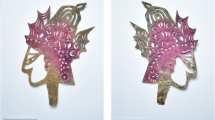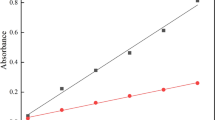Abstract
Cultural heritage parchments made from the reticular dermis of animals have been subject to studies of deterioration and conservation by amino acid analysis. The reticular dermis contains a varying mixture of collagen I and III (COL I and III). When dealing with the results of the amino acid analyses, till now the COL III content has not been taken into account. Based on the available amino acid sequences, we present a method for determining the amount of COL III in the reticular dermis of new and historical parchments calculated from the ratio of Ile/Val. We find COL III contents between 7 and 32 % in new parchments and between 0.2 and 40 % in the historical parchments. This is consistent with results in the literature. The varying content of COL III has a significant influence on the uncertainty of the amino acid analysis. Although we have not found a simple correlation between the COL III content and the degree of deterioration, our results show that this question must be taken into consideration in future studies of the chemical and physical deterioration of parchment measured by amino acid analysis and other analytical methods.







Similar content being viewed by others
References
Bailey AJ, Paul RG (1998) Collagen: a not so simple protein. J Soc Leather Technol Chem 82:104–110
Bhatnagar RS (2003) Collagen. In: Talwar GP, Srivastava LM (eds) Textbook of biochemistry and human biology, 3rd edn. Prentice Hall of India Private Limited, New Delhi, pp 75–90
Birkedal-Hansen H, Taylor RE, Bhown AS, Katz J, Lin HY, Wells BR (1985) Cleavage of bovine skin type III collagen by proteolytic enzymes. Relative resistance of the fibrillar form. J Biol Chem 260(30):16411–16417
Bowes JH, Raistrick (1964) The action of heat and moisture on leather—part V. Chemical changes in collagen and tanned collagen. J Am Leather Chem Assoc LIX(4):201–215
Bowes JH, Raistrick AS (1967) The action of heat and moisture on leather—part VI. Degradation of the collagen. J Am Leather Chem Assoc LXII(4):240–257
Bowes JH, Taylor JE (1971) Effect of dry heat on collagen and leather. J Am Leather Chem Assoc 66:96–117
Bozec L, van der Heijden G, Horton M (2007) Collagen fibrils: nanoscale ropes. Biophys J 92(1):70–75
Brandt LØ, Schmidt AL, Mannering U, Sarret M, Kelstrup CD, Olsen JV, Cappellini E (2014) Species identification of Archaeological skin objects from Danish bogs: comparison between mass spectrometry-based peptide sequencing and microscopy-based methods. PLoS One 9(9):1–10
Buckley M, Kansa SW, Howard S, Campbell S, Thomas-Oates J, Collins M (2010) Distinguishing between archaeological sheep and goat bones using a single collagen peptide. J Archaeol Sci 37(1):13–20
Engelman L (2009) Nonlinear Models. In: SYSTAT 13, Statistics III, Chicago, pp 273–328
Epstein EH (1974) [α1(III)]3 Human skin collagen release by pepsin digestion and preponderance in fetal life. J Biol Chem 249(10):3225–3231
Epstein EH, Munderloh N (1978) Human skin collagen. Presence of type I and type III at all levels of the dermis. J Biol Chem 253(5):1336–1337
Fleischmajer RD, MacDonald ED, Perlish JS, Burgeson RE, Fisher LW (1990a) Dermal Collagen fibrils are hybrids of type I and type III collagen molecules. J Struct Biol 105:162–169
Fleischmajer R, Perlish JS, Burgeson RE, Shaikh-Bahai F, Timpl R (1990b) Type I and type III COL interactions during fibrillogenesis. Ann N Y Acad Sci 580:161–175
Heidemann E (1993) Fundamentals of leather manufacture. Roether, Darmstadt
Heidemann E, Seba J, Tanay I, Lentze C, Rohn M, Kisselbach T (1992) Untersuchungen über die reifen Quervernetzungen der Rindshaut. Das Leder 4:75–85
Henkel W, Glanville RW (1982) Covalent crosslinking between molecules of type I and type III collagen. Eur J Biochem 122(1):205–213. doi:10.1111/j.1432-1033.1982.tb05868.x
Keene DR, Sakai LY, Bächinger HP, Burgeson RE (1987) Type III collagen can be present on banded collagen fibrils regardless of fibril diameter. J Cell Biol 105(5):2393–2402
Kennedy CJ, Wess TJ (2003) The structure of collagen within parchment—a review. Restaurator 24:61–80
Larsen R (1995) Fundamental aspects of the deterioration of vegetable tanned leather. PhD Thesis, The Royal Danish Academy of Fine Arts School of Conservation
Larsen R (2000) Experiments and observations in the study of environmental impact on historical vegetable tanned leathers. Thermochim Acta 365, special issue on Cultural Heritage and Environmental Implications, pp 85–99
Larsen R (2002) Materials. In: Larsen R (ed) Microanalysis of parchment. Archetype Publications, London, pp xix–xx (ISBN 1-873132-68-9)
Larsen R, Barkholt V, Nielsen K (1989) Amino acid analysis of leather. Preliminary studies in deterioration, accelerated ageing and conservation of vegetable tanned leather. Das Leder 40:153–158
Larsen R, Vest M, Poulsen DV, Kejser UB, Jensen AL (1996) Amino acid analysis. In: Larsen (ed) Deterioration and Conservation of Vegetable Tanned Leather, Environment Leather Project, European Commission DG XII, Research Report no. 6, Copenhagen, pp 39–68
Larsen R, Poulsen DV, Vest M, Jensen A (2002) Amino acid analysis of new and historical parchments. In: Larsen R (ed) Microanalysis of parchment. Archetype Publications, London, pp 93–99 (ISBN 1-873132-68-9)
Larsen R, Poulsen DV, Minddal K, Dahlstrøm N, Fazlic N (2007). Molecular damage of parchment studied by amino acid analysis. In: Larsen R (ed) Improved assessment of parchment (IDAP). Assessment, data collection and sharing of knowledge. Research Report No. 18. European Commission. Luxembourg: Office for Official Publications of the European Communities, pp 111–114
Lovell CR, Smolenski KA, Duance VC, Light ND, Young S, Dyson M (1987) Type I and III collagen content and fibre distribution in normal human skin during ageing. Br J Dermatol 117(4):419–428. doi:10.1111/j.1365-2133.1987.tb04921.x
Mühlen Axelsson K, Larsen R, Sommer DVP (2012) Dimensional studies of specific microscopic fibre structures in deteriorated parchment before and during shrinkage. J Cult Herit 13(2):128–136
Mühlen Axelsson K, Larsen R, Sommer DVP, Melin R (2014) Degradation of COL in parchment under the influence of heat-induced oxidation: preliminary study of changes at macroscopic, microscopic, and molecular levels. Stud Conserv. doi:10.1179/2047058414Y.0000000140
Odlyha M, Theodorakopoulos C, de Groot J, Bozec L, Horton M (2007) Thermoanalytical (macro to nanoscale) techniques and non-invasive spectroscopic analysis for damage assessment of parchment. In: Larsen R (ed) Improved assessment of parchment (IDAP). Assessment, data collection and sharing of knowledge. Research Report No. 18. European Commission. Luxembourg: Office for Official Publications of the European Communities, pp 73–87
Parry DW, Ricks SD (eds) (1996) Current research and technological developments on the dead sea scrolls. E. J. Brill, Leiden
Poulsen DV, Christensen IB, Minddal K, Dahlstrøm N, Larsen R (2007) The parchment damage assessment programme (PDAP). In: Larsen R (ed) Improved assessment of parchment (IDAP). Assessment, data collection and sharing of knowledge. Research Report No. 18. European Commission. Luxembourg: Office for Official Publications of the European Communities, pp 37–44
Ramshaw JAM (1986) Distribution of type III COL in bovine skin of various ages. Connect Tissue Res 14(4):307–314. doi:10.3109/03008208609017473
Reed R (1972) Ancient skins, parchments and leathers. Seminar Press. Ltd., London
Rück P (1991) Pergament Geschichte Struktur Restaurierung Herstellung. Jan Thorbecke Verlag GmbH & Co., Sigmaringen
Toniolo L, D’Amato A, Saccenti R, Gulotta D, Righetti PG (2012) The Silk Road, Marco Polo, a bible and its proteome: a detective story. J proteom 75:3365–3373
Vilaplana F, Nilsson J, Sommer DVP, Karlsson S (2015) Analytical markers for silk degradation: comparing historic silk and silk artificially aged in different environments. Anal Bioanal Chem 407:1433–1449
Wess TJ (2005) Collagen fibril form and function. Adv Protein Chem 70:341–374
Wilkinson L, Engelman L, Corter J, and Coward M (2009) Cluster analysis in SYSTAT. SYSTAT 13, Statistics. SPSS Science Marketing Department, Chicago
Author information
Authors and Affiliations
Corresponding author
Ethics declarations
Conflict of interest
The authors declare that they have no conflict of interest.
Additional information
Handling Editor: D. Tsikas.
Rights and permissions
About this article
Cite this article
Sommer, D.V.P., Larsen, R. Detection of COL III in parchment by amino acid analysis. Amino Acids 48, 169–181 (2016). https://doi.org/10.1007/s00726-015-2074-2
Received:
Accepted:
Published:
Issue Date:
DOI: https://doi.org/10.1007/s00726-015-2074-2




